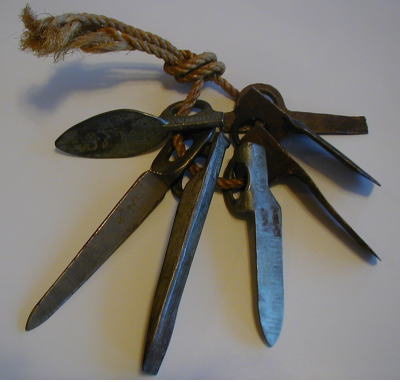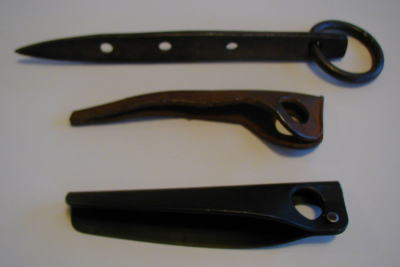Rupley Pitons


When I went over to John and Ila's house to do the interview, besides doing the interview, I wanted to get a piton as a souvenir. When I asked John about it, he took me down in his basement and began digging through laundry baskets full of climbing gear. After a couple of minutes, he fished out a group of seven pitons tied together with a short stand of hemp rope. When he handed me the pitons, my eyes bugged out and all I could think of was "Wow."
The strand of pitons is a wonderful collection of pitons. Most of the them were made in Europe and some of them are very stout, but some of them look they couldn't tolerate a fall of more than a few feet. One piton looks like it was made from 1/2 of a pair of scissors. John said that it was designed to twist in the rock - it's design never caught on. One piton looks like it was made with corregated metal that is about as thick as the metal on a tin roof.
John considered the strand of pitons junk ("One man's junk is another man's treasure") and they were not sure how or when the strand of pitons were assembled. One theory is that in European mountaineering, climbers often carried groups of pitons tied together and the pitons had been assembled for a climb and had been left tied together. Another theory, was the Ila and Eric (John and Ila's son) had assembled the collection of pitons for a show-and-tell at Eric's school. No matter how they were assembled, it is an amazing grouping of pitons.

John continued to dig through the laundry baskets for more pitons. The next piton he dug out was an early ice piton. It is about 6 inches long and has a ring in the end. John said that it didn't work very well, not nearly as good as the modern ice screws. According to friends, there is at least one of these pitons up on Mt. Lemmon, and maybe more, but no one seemed to remember where they were at.
The next piton John retrieved from the laundry baskets was a well used conventional piton. According to John, the piton was made in New York in the late '50s and is made of soft metal. There are many pitons like this on Mt. Lemmon.
The last piton is a Chouinard piton. This piton has a modern design that is still made by Black Diamond. John loves to climb with pitons and to John, the Chouinard piton is more than a piton - it is a work of art (and I would have to agree). The graceful, flaring design is made by folding piece of metal in half longitudinally and fastening it with a rivet. Truly a work of art.